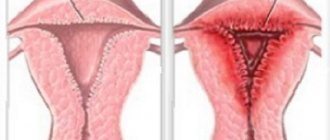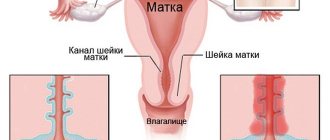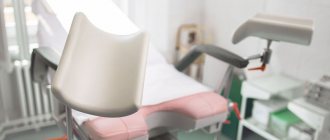An ovarian cyst is a benign neoplasm filled with fluid and prone to the accumulation of secretions. With prolonged development of the cyst, women experience pain, menstruation is disrupted, and other signs of the disease appear. Laparoscopy of an ovarian cyst, after which rehabilitation is faster, allows not only to eliminate the tumor, but also to preserve women's health.
The Yusupov Multidisciplinary Hospital is a modern medical institution where a woman can not only undergo examination and receive the necessary treatment, but also undergo rehabilitation after surgery. Recovery after laparoscopy of an ovarian cyst is carried out according to individually developed programs by a team of doctors.
Recovery after laparoscopy of an ovarian cyst
Laparoscopy is a minimally invasive procedure that is used by specialists at the Yusupov Hospital in the treatment of various diseases, in particular, when removing an ovarian cyst. This operation is performed under general anesthesia, during which three punctures are made in the abdomen through which a small camera and instruments are inserted. To make the operation easier, the abdominal cavity is inflated with a special gas.
The next stage is recovery after removal of the ovarian cyst. The duration of early rehabilitation in a hospital does not exceed 7 days. Patients of the Yusupov Hospital are accommodated in comfortable rooms equipped with the necessary furniture, communications and necessary supplies.
After the ovarian cyst has been removed by laparoscopy, the postoperative period at the Yusupov Hospital takes place under the guidance of experienced oncologists, rehabilitation specialists, and surgeons. Particular attention is paid to the patient during the period of recovery from anesthesia, when she is at her weakest.
Postoperative diet
The recovery period after surgery lasts up to 7 days, depending on the patient’s condition and the complexity of the operation. The most difficult is the first day. Modern medical techniques prescribe getting out of bed within a few hours after surgery. After 4-5 hours you are allowed to drink some water. And after 6-8 - liquid food is allowed.
During the first day of the recovery period, you can drink fermented milk products (kefir, yogurt) often, but little by little, so as not to overload the digestive system. Low-fat chicken or beef broth will be useful. It is better to drink it warm, no more than a glass.
On the second day, pureed vegetable soup is recommended - lean or with low-fat broth. As a second course - chicken or fish cutlet made from well-chopped meat and potato or zucchini puree.
On days 3-4, you can diversify your diet with vegetable stew or baked vegetables. Freshly squeezed juice and fruits without peel are allowed. They will help strengthen your immune system and cope with the disease faster. The first time after the operation, bloating is felt, so foods that can provoke or intensify it are excluded from the menu:
- cabbage;
- cucumbers;
- legumes;
- cauliflower;
- broccoli;
- citrus;
- onions and peppers.
Until the end of the recovery period and for some time after it, it is necessary to exclude from the diet:
- sweets and confectionery;
- too fatty dairy products: cream, sour cream;
- fatty meat and fish;
- fried foods;
- hot sauces and snacks;
- sparkling water and drinks;
- sour juices and drinks;
- tea, coffee, cocoa;
- all types of alcohol.
Complications after laparoscopy of ovarian cysts
The laparoscopic method is the most gentle in comparison with other methods, therefore, if medical recommendations are followed, recovery is carried out in the shortest possible time. However, due to various circumstances, patients may experience complications after removal of an ovarian cyst.
Negative consequences that may occur after laparoscopic surgery are:
- damage to neighboring tissues and organs as a result of insufficient visibility;
- intense bleeding;
- vascular damage;
- allergies to anesthesia or gas;
- increased body temperature;
- development of infectious diseases as a result of body weakness.
Specialists at the Yusupov Hospital are fluent in laparoscopy techniques and perform precise movements during tumor removal without damaging nearby tissues. If a patient at the Yusupov Hospital has pain in her ovary after laparoscopy of a cyst, specialists not only take the necessary measures to improve the woman’s condition, but also find out the causes of the pain.
Treatment
For small cysts, not exceeding 3 cm, existing for no more than 3 months, a wait-and-see approach is possible; the condition is the absence of tumor symptoms. To prevent the growth of the cyst or to reduce its size, conservative treatment using hormonal drugs may be prescribed. If there is no effectiveness within 2-3 cycles, surgical treatment is recommended. Indications for surgery are:
- The presence of a formation that has not disappeared on its own or under the influence of drug treatment;
- Cysts and tumors that appear with the onset of menopause;
- The presence of complications: torsion of the leg, suppuration, hemorrhage into the cyst or its rupture;
- Risk of malignancy.
Today, laparoscopic surgery is the “gold standard” in the treatment of cysts, performed through several small incisions in the abdomen, it lasts about 15-40 minutes, and due to minimal tissue trauma, rapid recovery is possible. In this case, the possibility of visualization of the cyst can be removed as carefully as possible, without affecting nearby structures. Moreover, healthy tissues are not affected, which is important for patients of reproductive age.
For a free written consultation, in order to determine the type of ovarian cyst and indications for surgery, as well as choosing the correct surgical treatment tactics, you can send me a complete description of the pelvic ultrasound, if possible, pelvic MRI data, blood results for tumor markers, to my personal email address, indicate age and main complaints. Then I will be able to give a more accurate answer to your situation.
Pain after removal of an ovarian cyst
Patients are most often bothered by pain after laparoscopy of ovarian cysts, the duration of which can reach 7 days. This symptom is a natural reaction of the body to damage; it occurs after the sutures have healed.
If a patient has pain in the ovary after removal of a cyst, she is advised to rest in bed; in addition, it is recommended not to make sudden movements and adhere to certain dietary rules. Medicines are prescribed by the attending physician if the pain intensifies.
Second phase
It begins on the eighth day after surgery. The patient is prescribed diet No. 5. There are many prohibitions. Therefore, it is easier to list what can be consumed:
- Soups: vegetarian, fruit, milk with pasta, borscht without broth, cabbage soup without meat, beetroot soup, as well as pea and pearl barley.
- Drinks: weak black tea with lemon, rosehip infusion, juices diluted with water, pureed compotes, chamomile infusion, jelly and fruit drinks.
- Pasta: low-fat pasta with permitted additives.
- Sweets: jelly, mousses with sugar substitute, marshmallows, meringue cookies, marmalade, candies without chocolate and cocoa, sour jam, gingerbread, dumplings with berries, Turkish delight without nuts, lollipops, nougat without nuts, sponge cake, caramel.
- Cereals: semolina, rice, oatmeal, buckwheat, millet. You can make casseroles, soufflés, puddings, etc. from them.
- Meat: turkey and chicken (without skin), rabbit, veal and lean beef, milk sausages, boiled/baked horse meat.
- Fish: hake, tuna, pollock, cod, pike perch, salmon, oysters.
- Bread: rye, bran, crackers, dry and biscuits, non-bread products, dry biscuits, crackers, crispbread.
- Other: pilaf with dried fruits, flaxseeds, bulgur, couscous, oatmeal, muesli, dumplings with chicken or veal, cabbage rolls.
Some vegetables and fruits are also allowed, even sauces and seasonings
Be that as it may, only a doctor can give nutritional recommendations to a patient, taking into account her health and condition after surgery
Discharge after laparoscopy of ovarian cyst
After surgery to remove an ovarian cyst using laparoscopy, many women report intense vaginal discharge consisting of mucus, blood and clots, which can last up to two weeks. After laparoscopy, the discharge from ovarian cysts is intense for a week, but in the second week the discharge decreases.
Pathological discharge that occurs during complications is distinguished by an unpleasant odor and a green or yellow tint. Curdled abnormal discharge indicates the development of an infectious process in the genital tract.
Specialists at the Yusupov Hospital pay close attention to each patient, so when pathological signs and complications appear, their signs are identified and therapeutic measures are prescribed, and the condition after laparoscopy of the ovarian cyst is assessed. Diagnostics carried out at each stage of treatment make it possible to identify possible disorders and determine the effectiveness of therapy.
Indications
One of the most common diseases of modern gynecology is the endometrioid ovarian cyst (a hollow formation measuring from 1.5 to 10 cm, inside which there is old coagulated brown blood) - requires medical diagnosis and surgical treatment.
Accordingly, the sooner a woman turns to a specialist, the less damage will be caused to the body, in particular to reproductive function. Women with a genetic predisposition to follicular formations should undergo a routine examination by a specialist. The cyst begins its development when menstrual blood enters the pelvic cavity through the tubes: cells of the inner surface of the uterus (endometrium) attach to various organs, including the ovaries, where they develop under the influence of progesterone and estrogen, causing regular inflammatory processes. Biochemical processes that occur during inflammation often lead to infertility.
An examination may be necessary if you have the following symptoms:
- pelvic pain before and during menstruation;
- significant discomfort during sexual intercourse;
- pain when urinating.
Since the disease is often asymptomatic, and the cyst may not bother you for many years, a routine examination by a gynecologist will help eliminate the risk of its development.
In most cases, an ovarian cyst is removed routinely, but endometriotic and other formations in the corpus luteum have a risk of rupture of the cyst capsule or malnutrition. If such factors are present, surgery is prescribed on an emergency basis and may be accompanied by removal of the appendage (tube and ovary on the affected side).
Sports after laparoscopy of ovarian cyst
Recovery after laparoscopy of an endometrioid ovarian cyst requires adherence to a mode of moderate activity. Thus, in the first days after surgery, physical activity is strictly limited. After a week of recovery and bed rest, the woman can take short walks and do light exercises. Physical activity helps eliminate stagnant processes in tissues and strengthen muscle tissue.
For a woman who has undergone laparoscopy of an ovarian cyst, training and serious sports activities should be postponed for 4 months in the postoperative period. Specialists at the rehabilitation clinic, together with the patient’s attending physician, draw up an individual recovery program, one of the components of which is physical therapy.
Process
Before diagnostic laparoscopy, a comprehensive examination of the patient is performed by the attending physician and anesthesiologist.
Stages of preparation for surgery:
- Connecting the patient to an IV and a monitor that monitors the heart.
- The use of general anesthesia, intravenous or combined with endotracheal.
- Administration of drugs intravenously to completely relax the body.
- Insertion of an endotracheal tube and further connection to a ventilator.
The surgical intervention itself is carried out in the following sequence:
- The Veress needle enters the cavity, after which carbon dioxide or nitrous oxide penetrates into the space.
- Insertion of hollow tubes, the needle is removed.
- Dissection of skin tissue and puncture with a trocar.
- After removing the trocar, the laparoscope is inserted.
- Removal of found formations/suppurations, biopsy. This stage may be skipped in the case of pure diagnosis or detection of a cancerous tumor.
- Removing instruments from the cavity.
Positions of the operated patient during diagnostic laparoscopy:
- raised pelvis above the upper body;
- the torso is raised above the pelvis;
- on the side.
Rehabilitation after removal of an ovarian cyst in Moscow
Some patients underestimate rehabilitation after removal of an ovarian cyst by laparoscopy. However, a set of measures selected taking into account the individual characteristics of the patient allows not only to prevent the development of complications, but also to preserve reproductive health.
Yusupov Hospital is located in the historical center of Moscow. In this medical institution, a staff of experienced specialists helps patients improve their quality of life and maintain health. Oncologists at the Yusupov Hospital diagnose and treat both malignant and benign tumors of various locations.
The key principle of the work of specialists at the Yusupov Hospital is the use of organ-preserving techniques and minimally invasive technologies for the treatment of various pathologies. So, if a woman has an ovarian cyst after removal of the uterus, the specialist will select treatment methods aimed at preserving the ovary. Medical care provided to patients at the Yusupov Hospital meets international standards.
Women who have had an ovarian cyst torsion, rupture or other complications can go to the Yusupov Hospital for emergency help at any time of the day. Pre-registration for a consultation with specialists at the Oncology Clinic is carried out by calling the Yusupov Hospital.
Menu additions
Representatives of the fair sex should not be upset by acquired limitations. All these are temporary measures necessary for better healing. As soon as everything is restored, she will be able to eat her favorite treats again.
You should also reduce the amount of physical activity and tune in to a positive mood, because the psychological state is an important point in normal rehabilitation. During the recovery period, girls should refrain from sexual contacts and sports.
All these are not the best factors for a quick, high-quality recovery. And although laparoscopy significantly shortens the rehabilitation period, you should not reach the point of fanaticism and try to reduce it further. A month is exactly how long the female body needs to return to a normal lifestyle.











